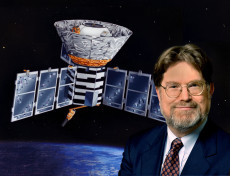Nobel Prize for Physics Leads List of Honors for NERSC Users in 2006
December 1, 2006
George F. Smoot, leader of a research team that was able to image the infant universe, revealing a pattern of minuscule temperature variations which evolved into the universe we see today, was awarded the 2006 Nobel Prize for physics.
Smoot, an astrophysicist at Lawrence Berkeley National Laboratory and a University of California at Berkeley physics professor, shares the award with John C. Mather of NASA Goddard Space Flight Center. The citation reads “for their discovery of the blackbody form and anisotropy of the cosmic microwave background radiation.”
On May 1, 1992, at a meeting of the American Physical Society, Smoot made an announcement that essentially silenced all the scientific critics of the Big Bang theory and helped change the course of future investigations into the origin and evolution of the universe.
Smoot and his research team, after analyzing hundreds of millions of precision measurements in the data they had gathered from an experiment aboard NASA’s Cosmic Background Explorer (COBE) satellite, had produced maps of the entire sky which showed “hot” and “cold” regions with temperature differences of a hundred-thousandth of a degree. These temperature fluctuations, produced when the universe was smaller than a single proton, were consistent with Big Bang predictions and are believed to be the primordial seeds from which our present universe grew.
The COBE data analysis was conducted using computers at Berkeley Lab and NASA’s Goddard Space Flight Center, but as subsequent experiments produced ever larger data sets, faster computers and bigger data archives were required. So, over the past ten years, Smoot and his colleagues studying cosmic microwave background (CMB) data have used nearly 5 million processor-hours and tens of terabytes of disk space at NERSC. In fact, around 100 analysts from a dozen CMB experiments are now NERSC users.
Two years ago, to simulate processing an entire year’s worth of data from Planck, the third-generation CMB space mission, Smoot’s team used 6,000 processors on NERSC’s Seaborg supercomputer for nearly two hours—the first time virtually all of the processors were used on a single code— mapping 75 billion observations to 150 million pixels. For comparison, the COBE sky map had used only 6,144 pixels.
More Information: George Smoot Wins Nobel Prize in Physics
About NERSC and Berkeley Lab
The National Energy Research Scientific Computing Center (NERSC) is a U.S. Department of Energy Office of Science User Facility that serves as the primary high performance computing center for scientific research sponsored by the Office of Science. Located at Lawrence Berkeley National Laboratory, NERSC serves almost 10,000 scientists at national laboratories and universities researching a wide range of problems in climate, fusion energy, materials science, physics, chemistry, computational biology, and other disciplines. Berkeley Lab is a DOE national laboratory located in Berkeley, California. It conducts unclassified scientific research and is managed by the University of California for the U.S. Department of Energy. »Learn more about computing sciences at Berkeley Lab.








